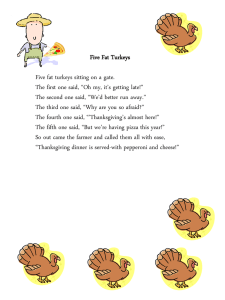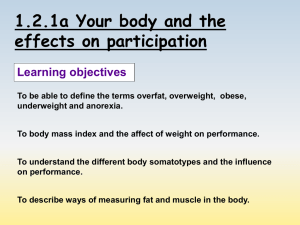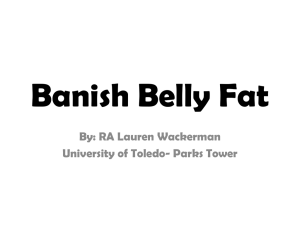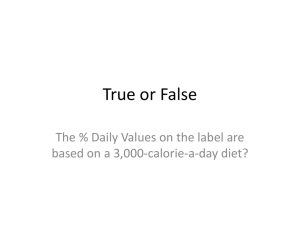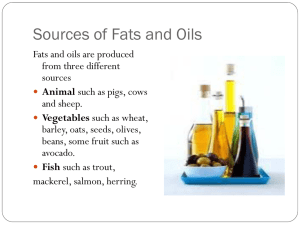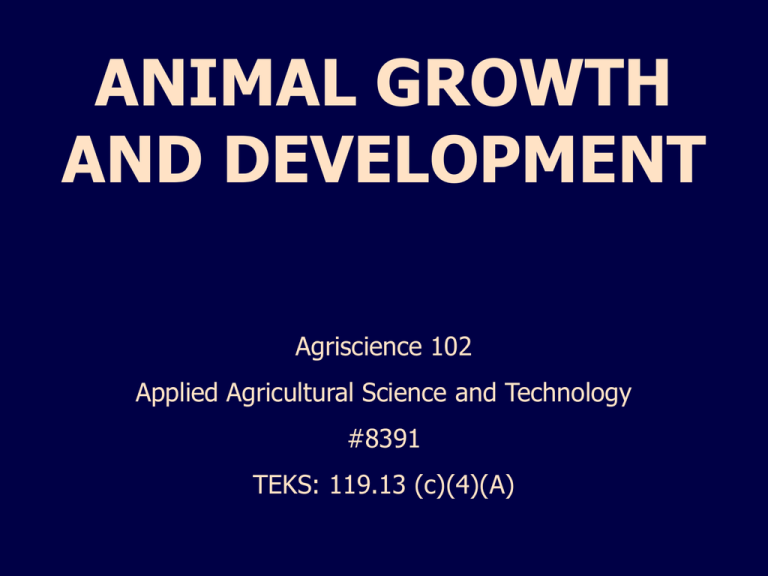
ANIMAL GROWTH
AND DEVELOPMENT
Agriscience 102
Applied Agricultural Science and Technology
#8391
TEKS: 119.13 (c)(4)(A)
Introduction
Growth and development have
important implications for domestic
animal production because they
significantly influence the value of
the animal being produced.
Photo by Keith Weller courtesy of USDA Agricultural Research Service.
A substantial proportion of
agricultural research focuses on
how to make animal growth and
development processes more
efficient.
This research involves several
disciplines because animal growth
and development are controlled
by genes and hormones.
Because growth and development
are continuous and dynamic
processes requiring integration of
numerous physiological functions,
they are influenced by:
• nutrition,
• efficiency of metabolism and
respiration,
• hormonal regulation,
• immune response,
• physiological status of the animal,
• diseases and parasites, and
• maintenance of homeostasis.
Animal growth and development
can be separated into processes
occurring before birth or hatching
(pre-natal) and those occurring
after birth or hatching (post-natal).
An animal originates from a single
cell (ovum or egg), which is
fertilized by the male spermatozoon
(sperm).
The resulting zygote then develops
in an enclosed environment (either
the uterus or an egg) for a certain
period of time known as gestation
or incubation period.
Length of gestation:
• in cattle – approximately 283 days;
• in sheep – approximately 150
days; and
• in swine – about 112 days.
The length of incubation of a chicken
egg is 21 days.
After they are born or hatched,
young animals experience a period
of rapid growth and development
until they reach maturity.
After an animal matures, some
processes stop (Ex. bone
elongation), while others slow
down (Ex. muscle deposition).
The maximum size of an animal
is determined by its genetics, but
nutrition and disease influence
whether the animal reaches its
genetic potential for size.
Pre-Natal Growth and
Development
Pre-natal growth and development
are broken down into two stages:
• embryogenesis, and
• organogenesis.
Embryogenesis
Embryogenesis extends from
the union of female and male
gametes to the emergence of the
embryonic axis and development
of organ systems at the neurula
stage.
During embryogenesis, the zygote
develops into the morula, which
becomes the blastula, and then
the gastrula.
The zygote is a single cell that is
repeatedly cleaved to form a
multi-celled ball known as the
morula.
Cleavage is a process that involves
mitotic division of the original cell
into two cells, which then divide in
to four cells and then eight cells.
Although the number of cells
double at each stage of cleavage,
individual cells do not grow or
enlarge in size.
So, the morula is the same size as
the original zygote, even though it
is made up of numerous cells,
called blastomeres.
Cleavage continues until the cells
of the developing embryo are
reduced to the size of cells in the
adult animal.
The cells of the morula are
rearranged to form a hollow sphere
filled with fluid.
At this stage,
the embryo is
referred to as
a blastula and
the fluid-filled space inside the
sphere is called the blastocoel.
The blastula undergoes a process
known as gastrulation and becomes
a gastrula.
Gastrulation of a diploblast: The formation of germ layers from a
(1) blastula to a (2) gastrula. Some of the ectoderm cells (orange)
move inward forming the endoderm (red).
Up until the gastrula stage, cell
division has occurred but the
blastomeres (cells) have not
increased in size.
It is when the embryo is in the
gastrula stage that cell growth
occurs at the same time as cell
division.
The process of gastrulation
involves extensive rearrangement
of the blastomeres.
The cells on one side of the
blastula move inward and form a
two-layered embryo.
The two layers formed are the
ectoderm (outer layer) and the
endoderm (inner layer).
A third cell layer known as the
mesoderm is formed between the
ectoderm and the endoderm.
The cavity that forms within the
gastrula is known as the primitive
gut; it later develops into the
animal’s digestive system.
All tissues and organs form from
one of the three layers of cells in
the gastrula.
After the germ layers are
established, the cells rearrange and
develop into tissues and organs.
During this phase, known as
organogenesis, cells grow and
differentiate.
Organogenesis
The process of organogenesis
extends from the neurela stage to
birth or hatching.
The neurela stage is distinguished
by differentiation, which is when
unspecialized embryonic cells
change into specialized cells
destined to form specific tissues
or organs.
Differentiation starts at the upper
surface to the gastrula.
Cells of the ectoderm divide and
form the neural plate.
Two raised edges or neural folds
appear and gradually come
together to form the neural tube.
A mass of cells called the neural
crest is pinched off the top of the
neural tube and then migrates to
other parts of the embryo to give
rise to neural and other structures.
Eventually, the front part of the
neural tube thickens and forms
the brain; the remainder of the
tube becomes the spinal cord.
In the first few weeks after
conception, cells differentiate into
organs and body structures.
The embryo is then referred to as
a fetus and the body structures
continue to grow and develop
until birth.
In horses, the embryo is referred
to as a fetus at about 40 days
following conception, while in
humans it takes approximately 56
days to develop the fetus.
Body tissues and organs are
formed in a specific sequence;
the head is formed before the
tail and the spinal cord is formed
before other organs.
Some highly differentiated cells,
such as brain and nerve cells,
cannot be replaced if they are
destroyed after the original number
is fixed during the fetal stage.
Thus, nerve cells that are seriously
damaged thereafter are not
replaced and usually remain
permanently damaged.
Muscle cell numbers are also
fixed during the fetal stage and
can only increase in size, not in
number.
Bone, and therefore skeletal size,
can be increased to a degree by
environmental conditions, but
not beyond the genetic potential
of the animal.
Post-Natal Growth
The period of post-natal growth
extends from birth or hatching
until death.
The length of this period depends
greatly on the species.
The average life span of a mouse
is about 2 years, while humans
and elephants live to be well over
60 years of age.
Sheep and cattle tend to live to
be around 15 and 30 years of
age, respectively.
Muscle, bone, and fat are the
three main types of tissues that
develop as an animal grows.
The rate of deposition depends
on the age of the animal and the
type of tissue being deposited.
Muscle fibers are formed from
multiple cells called myoblasts.
While the animal is still in the
prenatal stage, myoblasts fuse
together to form a myotube,
which develops into a muscle fiber.
As a result, one muscle fiber has
multiple nuclei.
Because no new fibers are formed
after birth, postnatal growth of
muscle is characterized by
increases in length and diameter.
Muscle fibers are predominantly
protein; fiber size is determined by
the rate of protein synthesis minus
the rate of degradation.
The deoxyribonucleic acid (DNA)
content of muscle cells also
increases as the animal develops.
Bone tissue grows both before
and after birth.
A bone grows in length through
the ossification or hardening of
the cartilage at each end.
After the cartilage on the ends of
a bone has completely hardened,
the bone stops growing.
However, bones have the capability
of increasing in width and can
repair themselves, if broken.
Although individual bones reach a
mature length and stop elongating,
bone tissue is constantly being
deposited and resorbed.
Fat tissue is comprised of fat cells
and connective tissue.
Fat cells increase or decrease in
size depending on the nutritional
status of the animal.
Two types of fat tissue include
white fat, which stores energy,
and brown fat, which maintains a
constant body temperature.
Fat is deposited in four different
areas throughout the body or
carcass.
Fat that is deposited in the
abdominal cavity around the
kidneys and pelvic area is called
intra-abdominal fat; it is usually
the first fat deposited.
Fat deposited just under the skin
is referred to as subcutaneous
fat, or backfat, and is usually the
largest amount of fat deposited.
Fat between the muscles of
animals is called intermuscular
fat, while fat deposited within the
muscle is called intramuscular fat.
The level of intramuscular fat is
referred to as the degree of
marbling and affects the quality
and taste of meat.
In the United States, an important
factor effecting the value of a beef
carcass is its quality grade, which
is determined by the degree of
marbling in the carcass.
Therefore, manipulation of the
this process is very important in
meat production systems.
Intramuscular fat is the last type
of fat to be deposited, so animals
with high degrees of marbling
also have large amounts of fat
deposited in other areas of the
carcass.
Deposition of Different Tissues
Muscle, bone, and fat are deposited
differently throughout the animal’s
life.
Bone elongation stops after the
animal reaches a mature body size,
but bone tissue deposition and
resorption continue until the animal
dies.
The majority of muscle tissue
develops between birth and
maturity.
Muscle growth then slows down,
but it is not physiologically halted
as is bone growth.
Fat deposition occurs mainly after
the bulk of the muscle has been
deposited.
It is a common misconception
that fat is only deposited in
middle aged or mature animals;
a significant amount of fat is
deposited in the young.
It is only because protein
deposition declines markedly
with age that fattening is more
apparent in mature animals.
The rate of deposition and the
amount of fat deposited depend
on the diet of the animal.
Young animals receiving an
overabundance of milk or
nutrients become fat.
During early stages of an animal’s
life, growth occurs very quickly.
After puberty, bone elongation
stops so skeletal size does not
increase much after that point,
although live weight continues to
increase.
In cattle, puberty occurs at about
10 months of age, while in sheep
and pigs it occurs around 6 and 5
months, respectively.
Hormonal Control
Deposition of different tissues and
partitioning of energy for various
processes involved in growth and
development are regulated by
hormones.
Some of the more important
hormones involved in growth and
development are insulin, growth
hormone, Insulin-like Growth
Factor 1 (IGF-1), thyroid
hormones, glucocorticoids, and
the sex steroids.
Insulin
Insulin is a very important
hormone involved in muscle
growth and development.
It stimulates the transport of
certain amino acids into muscle
tissue and is active in reducing
the rate of protein degradation.
Insulin is also a key hormone in
the regulation of food intake,
nutrient storage, and nutrient
partitioning.
Growth Hormone
Growth hormone stimulates
protein anabolism in many tissues.
This effect reflects increased
amino acid uptake, increased
protein synthesis, and decreased
oxidation of proteins.
Growth hormones enhance the
utilization of fat by stimulating
triglyceride breakdown and
oxidation in adipocytes.
In addition, growth hormones
seem to have a direct effect on
bone growth by stimulating the
differentiation of chondrocytes.
The growth hormone is one of
many hormones that serve to
maintain blood glucose within a
normal range.
For example, it is said to have
anti-insulin activity because it
suppresses the ability of insulin
to stimulate uptake of glucose in
peripheral tissues, and it enhances
glucose synthesis in the liver.
Somewhat paradoxically, the
administration of the growth
hormone stimulates insulin
secretion, leading to
hyperinsulinemia.
The major role of growth
hormone in stimulating body
growth is to stimulate the liver
and other tissues to secrete IGF-1.
Insulin-like Growth Factor 1
IGF-1 stimulates proliferation of
chondrocytes (cartilage cells),
thus resulting in bone growth.
It is also important in protein, fat,
and carbohydrate metabolism.
IGF-1 stimulates the
differentiation and proliferation of
myoblasts and the amino acid
uptake and protein synthesis in
muscle and other tissues.
Thyroid Hormones
Animals require thyroid hormones
for normal growth.
Deficiencies of T4 (thyroxine) and
T3 (tri-iodothyronine) cause
reduced growth as a result of
decrease muscle synthesis and
increased proteolysis.
Alterations in thyroid status require
several days to take effect and are
associated with changes in the
ribonucleic acid (RNA)/protein ratio
in skeletal muscle.
In addition, thyroid hormones have
an important influence on the
prenatal development of muscle.
Glucocorticoids
Glucocorticoids restrict growth and
induce muscle wasting; they have
different effects on different types
of muscle.
Some evidence indicates that
glucocorticoids also effect
metabolic rate and energy balance.
Sex Steroids
Androgens (male sex hormones)
have an obvious effect on muscle
development and growth in
general because male animals
grow faster and develop more
muscle than do females.
However, estrogens (female sex
hormones) also have significant
roles in maximizing growth and
are commonly used in artificial
growth promotants for both male
and female cattle.
Estrogen is thought to act
indirectly through its effects on
the secretion of other hormones.
However, it is believed that
androgens have a more direct
effect because of androgen
receptors located on muscle cells.
Homeostasis
Homeostasis is a concept that is
closely integrated with the growth
and development of an animal.
Normal growth patterns are
affected if homeostasis is not
maintained at all times.
Homeostasis refers to the animal’s
maintenance of an internal
equilibrium.
Many processes and functions,
both voluntary and involuntary,
contribute to maintaining this
state of internal balance, which is
controlled by the nervous system
(nervous regulation) and the
endocrine system (chemical
regulation).
Homeostasis is maintained at all
levels, from individual cells to the
whole animal.
For example, cells must maintain
suitable salt and water levels,
while tissues and organs require
specific blood glucose levels.
Therefore, maintaining a state of
homeostasis requires a high level
of interaction between hormonal
and nervous activities.
Another example of homeostasis
is the maintenance of a constant
internal temperature.
Temperature is something that
must be kept within a certain
range for an animal to remain
alive and grow and function
normally.
If an animal is becoming
increasingly hot, it may move
from an open area to a shaded
area to help reduce body heat.
This is a voluntary action
performed by the animal.
At the same time, the animal
may involuntarily start to sweat.
This is a mechanism that many
animals use to dissipate heat, but
it is not something controlled by
the animal.
Rather, it occurs automatically in
response to internal stimuli.
Genetic Control
Most processes involved in growth
and development are occurring at
a cellular level.
Because this is such a finite level,
it can be difficult to control or
manipulate these processes
outside of a scientific laboratory.
However, managers of livestock
systems must manipulate growth
and development to optimize
production.
Consequently, the knowledge of
what is happening at a cellular
level must be applied at a whole
animal level so that growth and
development can be managed.
Manipulation of genetics is an
important factor in the management
of livestock operations because the
genetic composition of an animal
determines its potential for growth
and development.
All animals have a set genotype
that determines their potential for
growth.
However, their phenotype is
affected by environmental factors,
including nutrition, disease,
parasites, and injuries.
Traits are heritable, which means
that they are passed on to an
individual from its parents;
however, some traits are more
heritable than others.
That is, the genotype of an
individual is expressed more
strongly and environment is less
influential for particular traits.
Specific genes code for different
traits and some traits are
influenced by multiple genes.
For example, rate of growth is a
trait influenced by many genes
controlling things such as appetite,
tissue deposition, skeletal
development, energy expenditure,
and body composition.
The genes for all of these traits
add together to produce the
growth rate we can measure.
Heritability of some growthrelated traits and how they differ
between species are listed in the
following table.
Effect of Genetics on Pre-Natal
Growth
Genetic potential for prenatal
growth can be inhibited by
environmental factors.
For example, prenatal growth in
chickens is limited by egg size
because of the amount of nutrients
available to the developing chick.
Photo courtesy of USDA Photography Center.
In litter-bearing animals, such as
swine and rabbits, birth weight of
individuals may be affected by the
size of the litter and, consequently,
the available uterine space and
supply of nutrients.
Photo courtesy of USDA Agricultural Research Service.
Embryos from small breed parents
have been transplanted into larger
breeds within the same species
resulting in birth weights that are
greater than their non-transplanted
contemporaries.
However, birth weights were not as
large as offspring of larger breeds
with the genetic potential for heavier
birth weights.
Effect of Genetics on Growth from
Birth to Weaning
Growth from birth to weaning is
affected significantly by the amount
of milk produced by the dam.
Photo by Ken Hammond courtesy of USDA Photography Center.
Many studies of swine indicate that
up to 20% of growth during this
period is controlled by heritability,
while 35% to 50% of the weaning
weight is affected by the milking
ability of the dam, litter size, and
other environmental factors.
In cattle and sheep, growth during
this period is more strongly related to
genetic ability, with heritability
estimates ranging from 20% to 30%.
Photo by Scott Bauer courtesy of USDA Agricultural Research Service.
Effects of Genetics on PostWeaning Growth
During the post-weaning period,
the individual’s genetic potential
for growth can be more easily
evaluated, provided the nutritional
levels are adequate and disease
and parasites are controlled.
Selecting for mature size
differences over time has developed
large and small strains of chickens,
rabbits, swine, cattle, and sheep.
The mature size of animals is
directly related to their rate of gain
and feed efficiency.
Large and late maturing animals
are still growing when they reach
conventional market weights and
are carrying less fat and waste.
These larger framed animals are
more suitable for markets
requiring lean meat.
Thus, the grower who produces
animals with high-yielding
carcasses is rewarded financially.
On the other hand, small and
early maturing animals have just
about finished growing when they
reach desirable market weights
and are frequently carrying much
higher proportions of fat.
So, in markets where marbling is
desired, this is a good
characteristic.
Combining Growth Traits with
Other Breeding Priorities
The objectives of individual
livestock production operations
need to be considered when
planning breeding programs.
Genetic manipulation through
breeding is a long-term
commitment; producers need to
carefully consider their long-term
market objectives and opportunities.
Most animals are produced for a
specific market; throughout Texas
and the United States, cattle
production is focused on feedlot
systems that produce meat almost
entirely for domestic consumption.
Photo by M. Jasek.
Cattle that produce high-yielding
carcasses, which possess sufficient
marbling, and have high feed
efficiencies are considered most
valuable.
All levels of production, including
cow-calf operations, stocker
operations, and feedlots, focus
on producing beef of acceptable
quality as efficiently as possible.
In Australia, cattle are grass-fed
until they are two to three years
old, resulting in leaner, larger
carcasses that are ultimately
destined for export to Asian
countries, such as Japan or the
Philippines.
Greater emphasis is placed on
growth rates in male animals and
calving percentages in females.
Survival is also a major factor to
be considered because of harsh
environmental conditions.
For example, tick resistance and
heat tolerance are very important
traits.
Selecting for increased growth
rates ultimately result in a line of
larger framed animals.
The negative results of this can
be decreased marbling and feed
efficiency, increased feed costs,
higher birth weights, and higher
rates of dystocia.
This has led some producers to
consider feed efficiency a more
suitable selection trait; however,
the heritability of feed efficiency
is low and genetic improvement
is slow.
For these reasons, selection
based on indirect traits may be
more effective.
The Influence of
External Factors
An animal never reaches its
genetic potential for growth,
fattening, milk production, egg
laying and other developmental
processes, if diet and
environmental conditions are not
optimal or at least favorable.
Nutrition
Nutrition is the variable that
managers of livestock production
systems have the most control
over in the short-term.
An animal requires a certain level of
nutrition for the normal development
and functioning of its body systems.
This is commonly referred to as the
maintenance requirements of an
animal.
Additional nutrients are then required
if optimal growth of muscle and fat
is to occur.
Poor nutrition can have multiple
consequences, such as:
• stunted growth,
• malformed organs,
• disease,
• brittle skeletons,
• increased susceptibility to
parasites, and
• poor reproductive performance.
All of these consequences lead to
reduced income for the owner of
the animals.
Consequently, livestock operations
spend a lot of time and money
trying to provide optimal nutrition
for their animals.
Photo by M. Jasek.
For more intensive
livestock operations,
such as swine and
cattle feeding
operations or
broiler grow-out
farms, feed costs can contribute to
more than 80% of the total costs
involved in producing an animal.
Photo by M. Jasek.
Nutrition affects
all stages of
growth and
development.
Photo by M. Jasek.
The nutritional status of the dam
throughout the gestation and
lactation periods has significant
effects on the offspring’s
development.
Poor nutrition in reproducing
females leads to low birth
weights and heavy death losses
in newborn progeny.
Species differ in how they adapt
to poor nutrition.
For example, sheep and cattle
partition as many nutrients as
possible into the fetus and even
use their own reserves to meet
nutritional deficiencies.
Iron deficiencies cause problems
because the dam utilizes her own
reserves to supply the iron
requirements for the growing
fetus.
In comparison, some species
abort the fetus if their nutritional
status falls below a certain level.
The effects of poor nutrition after
birth on postnatal growth and
ultimate mature size depend on
three factors:
1. the age at which poor nutrition
occurs,
2. the length of time during which
the animal was subjected to
poor nutrition, and
3. the kind of poor nutrition to
which the animal was
subjected (for example, a
specific imbalance of one or
more essential amino acids).
Poor nutrition at any stage in an
animal’s development has longterm effects.
For example, cattle that experience
a period of poor nutrition as young
calves never meet their genetic
potential to marble.
However, structural development
continues as normal if the period
of poor nutrition is relatively short
in duration.
Poor nutrition even provides a
benefit in the form of
compensatory growth.
Compensatory growth is a
phenomenon that has been identified
in animals that go through a short
period of malnutrition, but then
return to an adequate or high plane
of nutrition.
Animals lose weight or their
development is temporarily slowed
but, as the animal’s nutritional
status improves, they start utilizing
nutrients more efficiently.
Thus, the resulting weight gain
occurs more quickly and more
efficiently.
Nutrition is used to manipulate the
growth patterns of animals.
For example, in
feedlots, highenergy diets are
commonly fed in
the finishing phase
to encourage
deposition of fat (marbling).
Photo by M. Jasek.
The nutritional strategies used
depend on the desired endproduct, the age at turn-off, and
the available feed sources.
Diseases
Any form of disease negatively
impacts the growth and
development of an animal.
Sickness usually requires nutrients
to be repartitioned and commonly
causes reductions in intake.
Some diseases also create longterm consequences that impair
the animal’s ability to harvest,
digest, or absorb nutrients,
causing long-term impairment of
growth and development.
Parasites
The effect of parasites varies
from mild to severe and can be
as drastic as death.
Both internal and external parasites
cause:
• a decrease in appetite and,
therefore, decreased intake of
food.
• depressed wool production,
• inhibited normal digestive
functions,
• permanent internal tissue
damage, and
• the animal to become physically
sick (for example, blood
poisoning by ticks).
Many treatments are available to
prevent and combat parasitic
infections.
Cattle going through tick
treatment bath at APHIS
facility (McAllen, TX) to
control cattle fever ticks.
Photo by Scott Bauer courtesy of USDA Agricultural Research Service.
The Aging Process
in Animals
Aging involves a series of
changes in animals that lead
to physical deterioration and
eventually to death.
There is an age at which each
species reaches the peak of its
productive life.
For example, maximum egg
laying is highest during a hen’s
first year of production;
maximum litter size in swine
occurs at 3 to 4 years of age.
It has been said that as an animal
is born, it begins to die.
Photo by Scott Bauer courtesy of USDA Agricultural Research Service.
In a physiological sense, this is
true, because shortly after
formation of the embryo, cells of
certain tissues stop dividing.
Subsequently, cell division stops
in other tissues until only those
tissues essential to the
maintenance of life (that is, skin
and blood) continue to divide.
An animal’s longevity is roughly
proportional to the length of time
required for the animal to reach
maturity.
For example, rabbits, which reach
maturity in about 6 months, have a
life expectancy of about 4 years.
Cattle require 2 to 3 years to
mature and have a life
expectancy of 20 to 25 years.
Most physiological functions of
animals deteriorate with age.
The reproductive organs secrete
lower levels of hormones,
muscular strength and speed of
motion decline, and reaction time
is increased.
The time required for recovery
from body substance imbalances
becomes longer with age.
Collagen or proteins in the skin and
blood vessels become less elastic
with age; thus, wrinkles form and
vessels collapse or burst.
An increased breakdown of neural
and glandular control involved in
the aging process also occurs.
Reproductive and lactating
abilities of females decrease with
age, lowering their productivity.
Sows become inefficient producers
even earlier because they reach
excessive sizes creating higher
body maintenance requirements
and resulting in more injuries to
baby pigs.
Therefore, sows are frequently
culled by 3 years of age.
Cows are usually culled from the
breeding herd at 10 to 11 years
and ewes at 7 to 8 years.
Many factors, both genetic and
environmental, affect the life span
of animals.
Longevity of animals is a heritable
trait, so it can be estimated by
knowing the life span of an
individual’s parents and siblings.
Moreover, life span is decreased if
an animal is required to produce
at higher than normal levels for a
substantial period of time.
This is commonly seen in highproducing dairy cows.
Inadequate or excessive nutrition
also hastens the aging process.
Higher environmental temperatures
seem to shorten life expectancy.
The sex of an animal appears to
be involved in longevity because
females usually outlive males.
ALL RIGHTS RESERVED
Reproduction or redistribution of all, or part, of this
presentation without written permission is
prohibited.
Instructional Materials Service
Texas A&M University
2588 TAMUS
College Station, Texas 77843-2588
http://www-ims.tamu.edu
2007

